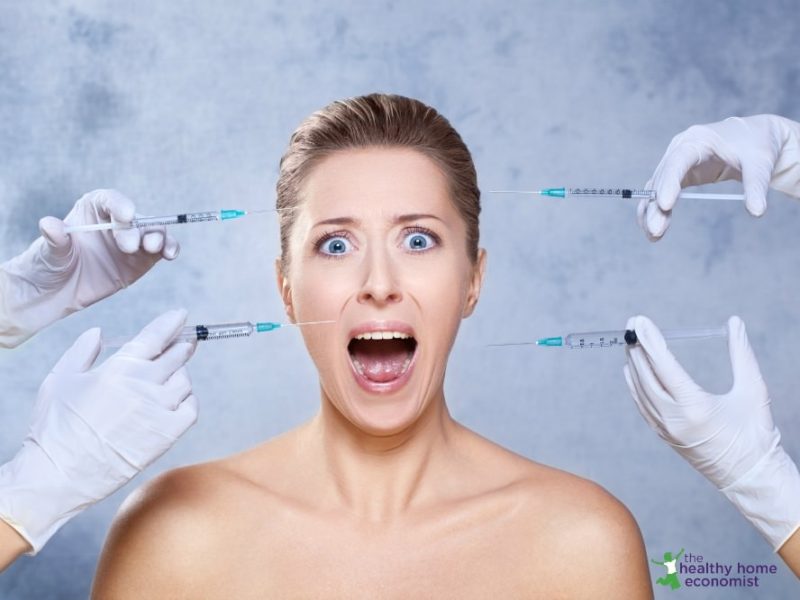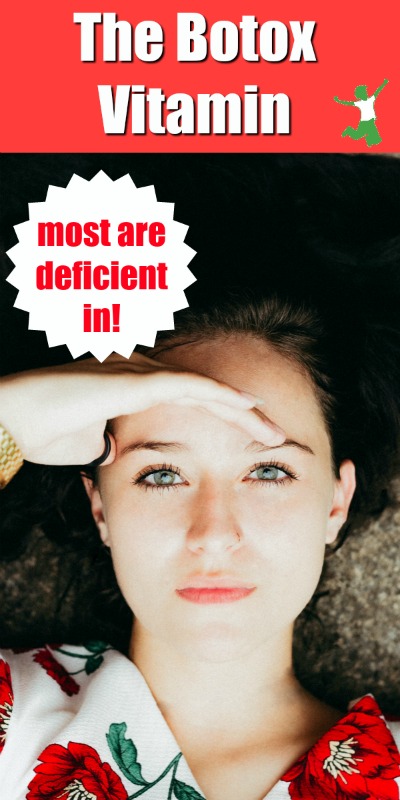Table of Contents[Hide][Show]
The vitamin deficiency that is widespread and most tellingly shows up as excessive wrinkling of the face.

Are wrinkles an inevitable fact of aging, or could laugh lines and crow’s feet potentially indicate a vitamin deficiency or even a more serious underlying health issue?
At a meeting of the Endocrine Society in Boston, researchers presented findings that revealed that women in their 40s and 50s who have extensive skin wrinkling are much more likely than their peers to have low bone mass. (1)
Researchers noted the relationship between wrinkles and bone density in every single bone tested which included hip, heel, and lumbar (spine).
In addition, this relationship existed regardless of body fat percentage and age.
Epidemiological evidence of Asian women offers further health clues to the wrinkle mystery. (2)
It is known that Japanese women have fewer wrinkles and less skin sagging that women of the same age living in North America.
These two groups of women vary greatly in diet and lifestyle, however.
Even when Japanese women living in Tokyo were compared with women from the Asian cities of Shanghai and Bangkok, they showed the least visible signs of aging.
Diet and lifestyle factors for these three Asian groups of women are comparable, except for one notable exception: consumption of natto in Japan.
Vitamin K2. The Anti-Wrinkle Vitamin
Tokyo residents frequently enjoy natto, a strong-smelling food traditionally made from fermented soybeans for breakfast.
Natto is loaded with menaquinone, more popularly known as Vitamin K2, and blood samples of the Tokyo women revealed high circulating levels of this fat-soluble vitamin.
Soy-free natto is also high in K2, as it is the specialty probiotic culture that imparts the nutrient, not the legume itself.
Further research bolstering the notion that getting plenty of anti-wrinkle vitamin K2 in the diet makes for smoother facial features is found in the research of Korean scientists and was published in the journal Nephrology. (3)
The rate at which the kidneys are able to filter the blood is an important measure of overall kidney function.
Researchers found that reduced renal filtration rate was associated with increased facial wrinkling.
What does decreased kidney filtration rate predict?
You guessed it – Vitamin K2 deficiency, according to American research published the year after the Korean study.
90% Deficiency Rate!
Testing has been limited so far on the true extent of Vitamin K2 deficiency in the western world.
However, of the testing conducted so far, a whopping 90% of people are deficient in this critical nutrient.
No wonder botox is such a popular cosmetic treatment!
No surprise that the sacred foods of traditional cultures were some of the highest Vitamin K2 containing foods!
Foods with the Anti-Wrinkle Vitamin
If you want to avoid a vitamin deficiency of K2, know that it is an elusive nutrient and extremely difficult to obtain with a modern diet.
The highest sources of K2 are:
- Natto (fermented soybeans)
- Goose liver
- Certain cheeses (Gouda has the most K2)
- Animal fats like egg yolk, butter, butter oil, ghee, and lard which must come from grassfed animals.
Natto contains 1,103 mcg of K2 per 3.5 ounce/100 gram portion which is far higher than any other food.
The second highest food in Vitamin K2 is goose liver pate which has 369 mcg per 3 1/2 ounce portion.
While delicious and wonderful to eat, goose liver pate is very hard to find in most places. It is also a very high-end, gourmet food, which makes the price out of reach for most.
Rounding out the top 3 foods highest in Vitamin K2 is none other than the humble Gouda cheese, which boasts 75 mcg per 3 1/2 ounce serving!
Brie contains significant K2 as well.
This compares to pastured egg yolks and butter, which each have about 15 mcg of K2 per 3 1/2 ounce portion.
How much of these K2 containing foods should you eat to avoid a vitamin deficiency of this critical nutrient?
That part gets murky as the official recommended daily intake (RDI) of Vitamin K doesn’t distinguish between K1 and K2 despite their very different uses in the body.
The RDI for Vitamin K is only determined by the liver’s requirement for normal blood clotting factors, not the K2 needed for optimal bone and kidney health and wrinkle-free skin.
Thus, getting enough K1 in the diet via leafy greens could still mean a serious deficiency of Vitamin K2.
There is also no solid evidence that the human body is able to convert Vitamin K1 to Vitamin K2, which is what occurs in grazing animals.
The good news is that there is no known toxicity of Vitamin K2, unlike other fat-soluble vitamins.
So, eating generously of Vitamin K2 rich foods as practiced by Traditional Societies and even potentially taking a supplement to avoid a vitamin deficiency is considered wise by Dr. Kate Rheaume-Bleue, ND, author of Vitamin K2 and the Calcium Paradox.
Plant vs Animal K2
Vitamin K2 is available in both animal fats and fermented foods. The animal form is MK-4 and the fermented form is MK-7.
Recent research has shown that emu oil, an Aboriginal sacred food, is extremely high in MK-4, nearly as high as goose liver pate!
This vetted source of pastured emu oil from a genetically pure strain of birds eating their native diet is the type to source.
Some people claim that putting emu oil directly on the skin is also helpful for anti-wrinkling effects. It certainly can’t hurt to try this, but I would not rely on transdermal emu oil alone. Eating high Vitamin K2 foods regularly is crucial.
Note that not all emu oil contains K2…only the fat from pastured birds!
For those who prefer the fermented form of K2 (MK-7), this quality brand offers therapeutic doses of the wrinkle-reducing vitamin from nonGMO natto extract.
As for me, I prefer to get nutrients from food as much as possible. While I will take Vitamin K2 supplements in a pinch, I am currently eating 1-2 tablespoons of homemade natto (MK7 form of Vitamin K2) and 1/2 teaspoon of grassfed ghee (MK4 form of Vitamin K2) every day as my whole food sources. When combined with a traditional diet, this provides about 200-400 mcg of Vitamin K2 per day.

(1) No Joke! Laugh Lines May Reveal Bone Health
(2) Vitamin K2 and the Calcium Paradox: How a Little-Known Vitamin Could Save Your Life
(3) Facial wrinkles as a predictor of decreased renal function
More Information
The Best Vitamin K 2 Supplement
Benefits of Vitamin K2
Macrobiotic Diet and Extreme Vitamin Deficiency
Emu Oil Benefits








I have a lot of wrinkles and very good bones, so I’m wondering if it isn’t my exposure to the sun over the years that caused wrinkles and also genetics as my father had a lot of wrinkles too.
Yes to both. If your skin is very thin, dry, and gentle then it will age faster. I knew so many women who had beautiful skin when they were young. They had baby’s skin, but this beauty did not last long, unfortunately. Every one of them got fine wrinkles like crumbled paper very yearly in life and they could not reverse it naturally. My skin is thick and oily. I had acne prone skin and it was not so attractive, but my parents and grandparents looked young very long and almost no wrinkles until they were over 60.
So what is it about Gouda that makes it have more K2?
It’s the bacteria that is used to produce the gouda. Brie uses the same/similar bacteria. If you have healthy gut flora, it will produce some K2 for you. However, the majority of what it (gut flora) produces is tied up somehow (I think in the nucleus), so it isn’t bioavailable. Dr. Kate’s book that Sarah mentions at the end is being re-printed this month. I’m getting one (probably on Amazon). If you are more curious about it, her book is probably a good source of information.
Carolyn Reid little article on Vit K2 you might enjoy 🙂
Be sure to ask around and find farmers whose egg-laying hens are out on fresh green grass, eating the bugs and grubs harbored in grass since this is what provides these nutrients. Ideally, they are following cows, scratching up the cow pies, eating the bugs, replenishing the land and becoming super nutrient dense. No “vegetarian fed” hens–they need the bugs, grubs and worms.
Vitamin K2 seems to be the compound identified by Weston A. Price as ”Activator X.” He found a way to make a concentrated form by centrifuging cream from cows eating actively growing grass. This is known as “high vitamin butter oil” which we are fortunate to be able to purchase from Green Pastures and Nutrapro. Weston A. Price discovered that a traditional diet supplemented with high vitamin butter oil and traditional cod liver oil was powerfully healing.
Very interesting. I’ve got the pastured eggs and butter going, but will look into some organic natto.
The best prevention: preparation h. Think about it.
I will take wrinkles over natto, lol.
Please do not encourage goose liver pate-it is very cruelly produced.
thank you, kathy, for bringing up the cruelty.
i do not understand how people think they can
gain ‘health’ for themselves by torturing and
slaughtering other life forms.
cheers ~
arcadia
Thanks for the blog post! We recently started using the MK-4 drops, but I just ordered the MK-7 that you recommend. Thanks for all that you do! I’ve learned so much from you!